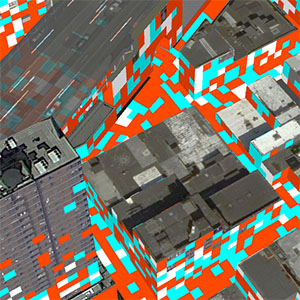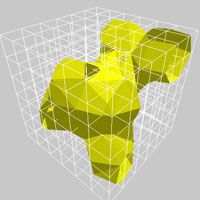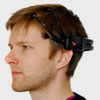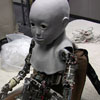
The Cloud Lab at the Columbia University Graduate School of Architecture, Planning & Preservation
An experimental lab that explores the design of our environment through emerging technologies in computing, interface and device culture.
The Lab | Projects & Events | Downloads | People
2014
DUMBO Neural Cartography with The Van Alen Institute
A project to visualize a day in the mental life of a neighborhood.
A project to visualize a day in the mental life of a neighborhood.
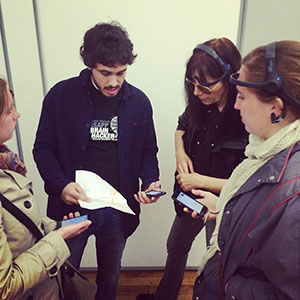
A public program bridging neuroscience and architecture, probing the built environment's role in our mental well-being.
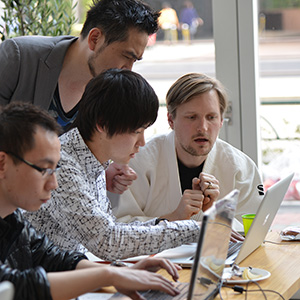
Competition-based code instruction. Learn to program with simple visual programming challenges.
2013
ComputationalGeometry, 2013
Open-source library for generating 3D printable meshes and models within Processing.
Open-source library for generating 3D printable meshes and models within Processing.
Yukiyasu Kamitani Interview, 2013
Interview with a pioneer in brain computer interface, working in dream visualization and the quantification of mental images.
Interview with a pioneer in brain computer interface, working in dream visualization and the quantification of mental images.
Kinect Exporter, 2013
Simple utilities to save, load and view 3D captured data from Microsoft Kinect
Simple utilities to save, load and view 3D captured data from Microsoft Kinect
2012
Code Dojo Beta, 2012
Learning programming through competitive, event-based instruction.
Learning programming through competitive, event-based instruction.
Human Sensing, 2012
Presented at the New York AIA's "Going Viral" and Architect Magazine's "Architect 50 Leadership Lab"
Presented at the New York AIA's "Going Viral" and Architect Magazine's "Architect 50 Leadership Lab"
Highline Neural Cartography, 2012
Continuing efforts to map the city with new technologies such as Brain-Computer Interfaces.
Continuing efforts to map the city with new technologies such as Brain-Computer Interfaces.
EMG-based design research, 2012
Working with obeserved electrical activity in the muscles to create smart hospital rooms. Led by Pablo Ros.
Working with obeserved electrical activity in the muscles to create smart hospital rooms. Led by Pablo Ros.
AAR Inteview, 2012
Discussing applied research in architectural education.
Discussing applied research in architectural education.
EEG-Based Design System
Exploring neural computing for design, with Neuromatters Inc.
Exploring neural computing for design, with Neuromatters Inc.
Architecture in the Cloud, 2012
An article exploring what is at stake for architects in cloud computing.
An article exploring what is at stake for architects in cloud computing.
2011
Eye Tracking Architecture, 2011
Using the EyeWriter DIY eye tracking system, the goal of this research is to understand the complex interplay between spatial information seeking and processing.
Using the EyeWriter DIY eye tracking system, the goal of this research is to understand the complex interplay between spatial information seeking and processing.
Lincoln Center Neural Cartography, 2011
The project uses EEG brain-scanning to understand the physical environment's affect on the brain.
The project uses EEG brain-scanning to understand the physical environment's affect on the brain.
Spatial Processing and Solvability with Columbia Laboratory for Intelligent Imaging and Neural Computing, 2011
Kinect Digital Lathe, 2011
The conventional lathe becomes a departure point to investigate how inexpensive motion capture technology can infuse new possibilities in 3D modeling.
The conventional lathe becomes a departure point to investigate how inexpensive motion capture technology can infuse new possibilities in 3D modeling.
Structural Triage System, 2011
Using commercial brain computer interface technology to create a real-time structural analysis platform.
Using commercial brain computer interface technology to create a real-time structural analysis platform.
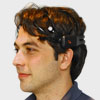
Using Brain Computer Interface and bio‐feedback technologies to link the capacities of the brain and body to computational generation of the environment..
OpenJapan NYC with OpenSimSim
OpenJapan brought 9 cities together to contribute design thinking to relief activities in Japan. 100+ ideas initiated in Japan were iterated by groups of designers working in the context of a 72 hr design marathon.
OpenJapan brought 9 cities together to contribute design thinking to relief activities in Japan. 100+ ideas initiated in Japan were iterated by groups of designers working in the context of a 72 hr design marathon.
2010
3D Scanning of Low Library, Columbia University, 2010
A project with the CU Robotics Group to scan Low Library, a historic structure located at the heart of Columbia University.
A project with the CU Robotics Group to scan Low Library, a historic structure located at the heart of Columbia University.
Hiroshi Ishiguro Interview, 2010
Interview with robotics designer Hiroshi Ishiguro. Ishiguro discusses his thoughts on the future of robotics, the environment and human experience.
Interview with robotics designer Hiroshi Ishiguro. Ishiguro discusses his thoughts on the future of robotics, the environment and human experience.
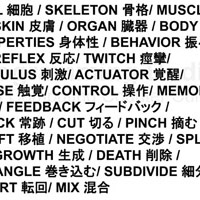
A symposium featuring interviewees including Hirosihi Ishiguro and Ken Sakamura, as well as presenters from the GSAPP alumni network to highlight the role technology is playing in architectural discourse.
Multi-Touch Spatial Interface, 2010
Integrating low-cost Infrared touch-screen technology and computer vision libraries to create architecture-scaled interfaces
Integrating low-cost Infrared touch-screen technology and computer vision libraries to create architecture-scaled interfaces
The Cloud Lab is directed by Toru Hasegawa and Mark Collins
The lab resides at the Graduate School of Architecture Planning & Preservation, Columbia University
400 Avery Hall 1172 Amsterdam Avenue New York, NY 10027
Contact us at inquiries @ thecloudlab.org
Copyright 2014
The lab resides at the Graduate School of Architecture Planning & Preservation, Columbia University
400 Avery Hall 1172 Amsterdam Avenue New York, NY 10027
Contact us at inquiries @ thecloudlab.org
Copyright 2014
